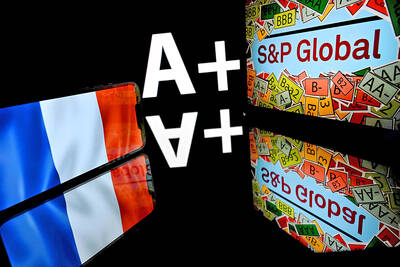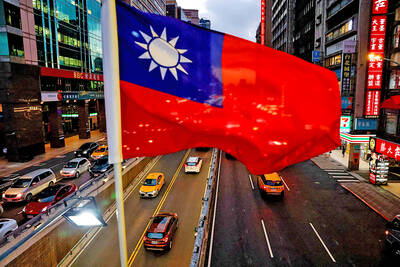US chip production is poised to explode in coming years, helping ease a risky dependency on East Asia, according to a projection by the Semiconductor Industry Association (SIA).
Semiconductor manufacturing capacity in the country will triple by 2032, an SIA-commissioned study by the Boston Consulting Group found. That will take the US share of the industry to 14 percent, up from 10 percent currently, according to the report, which was released yesterday.
The surge will reverse a downward trend for domestic chip production, which had been decamping for Asia in recent decades. Were it not for government funding programs like the 2022 CHIPS and Science Act, the US share was on course to shrink to 8 percent, the study found.

Photo: Reuters
The Washington-based SIA, which lobbied hard for the CHIPS Act, is eager to show that the legislation is paying off. It also wants the US government to devote more funding to the cause.
“We’ve always said that the CHIPS Act was a strong first step, but we’re going to need more to get to the promised land,” SIA chief executive officer John Neuffer said in an interview. “Our industry fully understands that we have an over-concentration of manufacturing in East Asia.”
The CHIPS Act set aside US$39 billion in grants — plus US$75 billion in loans and loan guarantees, and 25 percent tax credits — to persuade semiconductor firms to build factories on American soil.
In the wake of that legislation, the US has secured commitments from all five of the world’s top chipmakers to add facilities in the country. That includes the three main manufacturers of cutting-edge logic chips, the components that serve as the brains of devices: Taiwan Semiconductor Manufacturing Co (台積電), Samsung Electronics Co and Intel Corp.
US Secretary of Commerce Gina Raimondo, whose agency is responsible for doling out CHIPS Act funds, has said the US aims to produce one-fifth of the world’s advanced logic chips by the end of the decade.
Building some extra capacity also will help protect against the kind of disruptions that occurred during the COVID-19 pandemic, Neuffer said. But that represents a shift away from the industry valuing efficiency above all else.
The US isn’t the only one increasing its chip manufacturing ambitions, according to the report. China is building about 30 new facilities for parts of the chip supply chain, topping the US’s 26. And there are eight such projects under way in the European Union.

France cannot afford to ignore the third credit-rating reduction in less than a year, French Minister of Finance Roland Lescure said. “Three agencies have downgraded us and we can’t ignore this cloud,” he told Franceinfo on Saturday, speaking just hours after S&P lowered his country’s credit rating to “A+” from “AA-” in an unscheduled move. “Fundamentally, it’s an additional cloud to a weather forecast that was already pretty gray. It’s a call for lucidity and responsibility,” he said, adding that this is “a call to be serious.” The credit assessor’s move means France has lost its double-A rating at two of the

Jensen Huang (黃仁勳), founder and CEO of US-based artificial intelligence chip designer Nvidia Corp and Taiwan Semiconductor Manufacturing Co (TSMC, 台積電) on Friday celebrated the first Nvidia Blackwell wafer produced on US soil. Huang visited TSMC’s advanced wafer fab in the US state of Arizona and joined the Taiwanese chipmaker’s executives to witness the efforts to “build the infrastructure that powers the world’s AI factories, right here in America,” Nvidia said in a statement. At the event, Huang joined Y.L. Wang (王英郎), vice president of operations at TSMC, in signing their names on the Blackwell wafer to

AI BOOST: Although Taiwan’s reliance on Chinese rare earth elements is limited, it could face indirect impacts from supply issues and price volatility, an economist said DBS Bank Ltd (星展銀行) has sharply raised its forecast for Taiwan’s economic growth this year to 5.6 percent, citing stronger-than-expected exports and investment linked to artificial intelligence (AI), as it said that the current momentum could peak soon. The acceleration of the global AI race has fueled a surge in Taiwan’s AI-related capital spending and exports of information and communications technology (ICT) products, which have been key drivers of growth this year. “We have revised our GDP forecast for Taiwan upward to 5.6 percent from 4 percent, an upgrade that mainly reflects stronger-than-expected AI-related exports and investment in the third

RARE EARTHS: The call between the US Treasury Secretary and his Chinese counterpart came as Washington sought to rally G7 partners in response to China’s export controls China and the US on Saturday agreed to conduct another round of trade negotiations in the coming week, as the world’s two biggest economies seek to avoid another damaging tit-for-tat tariff battle. Beijing last week announced sweeping controls on the critical rare earths industry, prompting US President Donald Trump to threaten 100 percent tariffs on imports from China in retaliation. Trump had also threatened to cancel his expected meeting with Chinese President Xi Jinping (習近平) in South Korea later this month on the sidelines of the APEC summit. In the latest indication of efforts to resolve their dispute, Chinese state media reported that